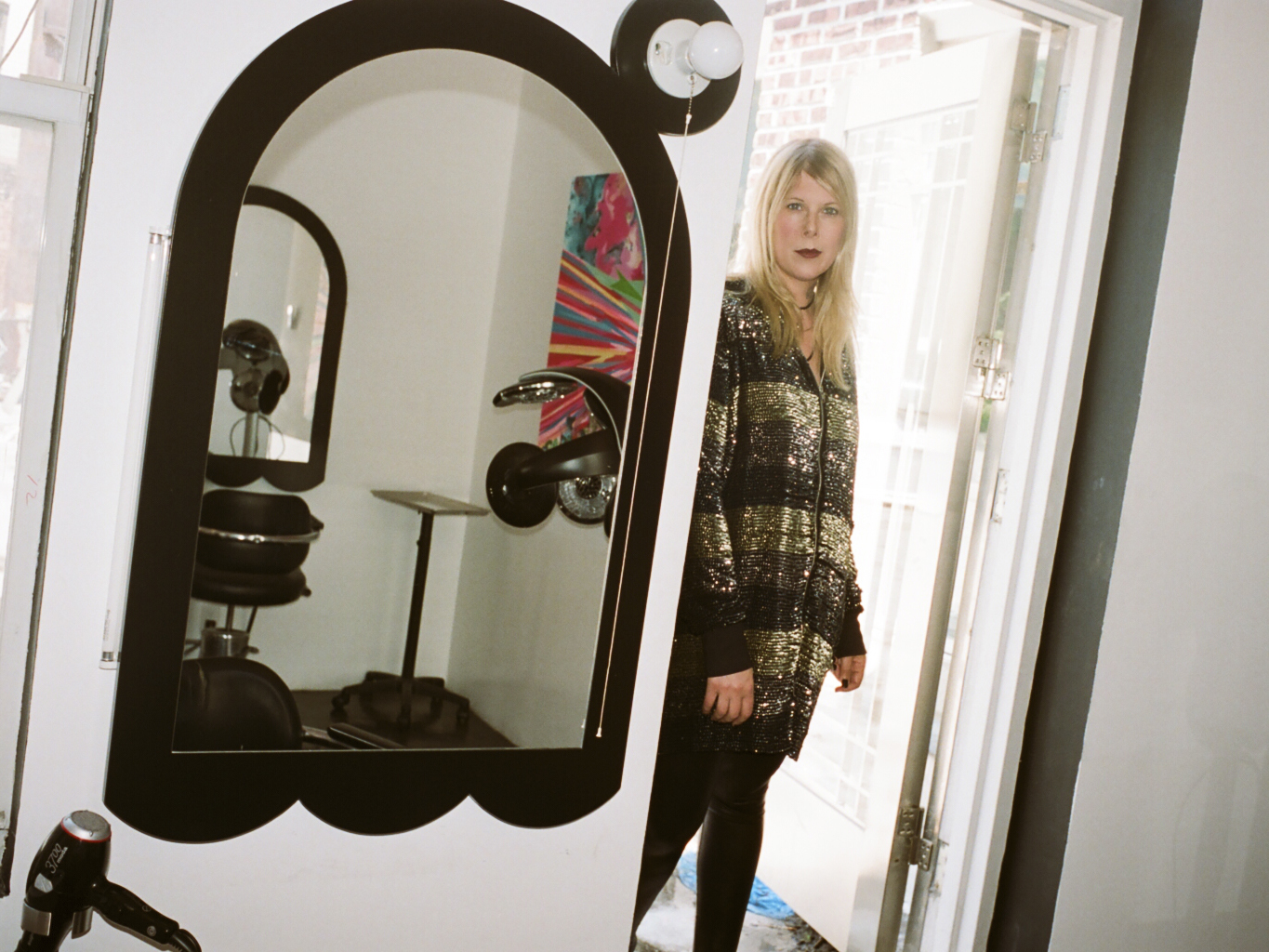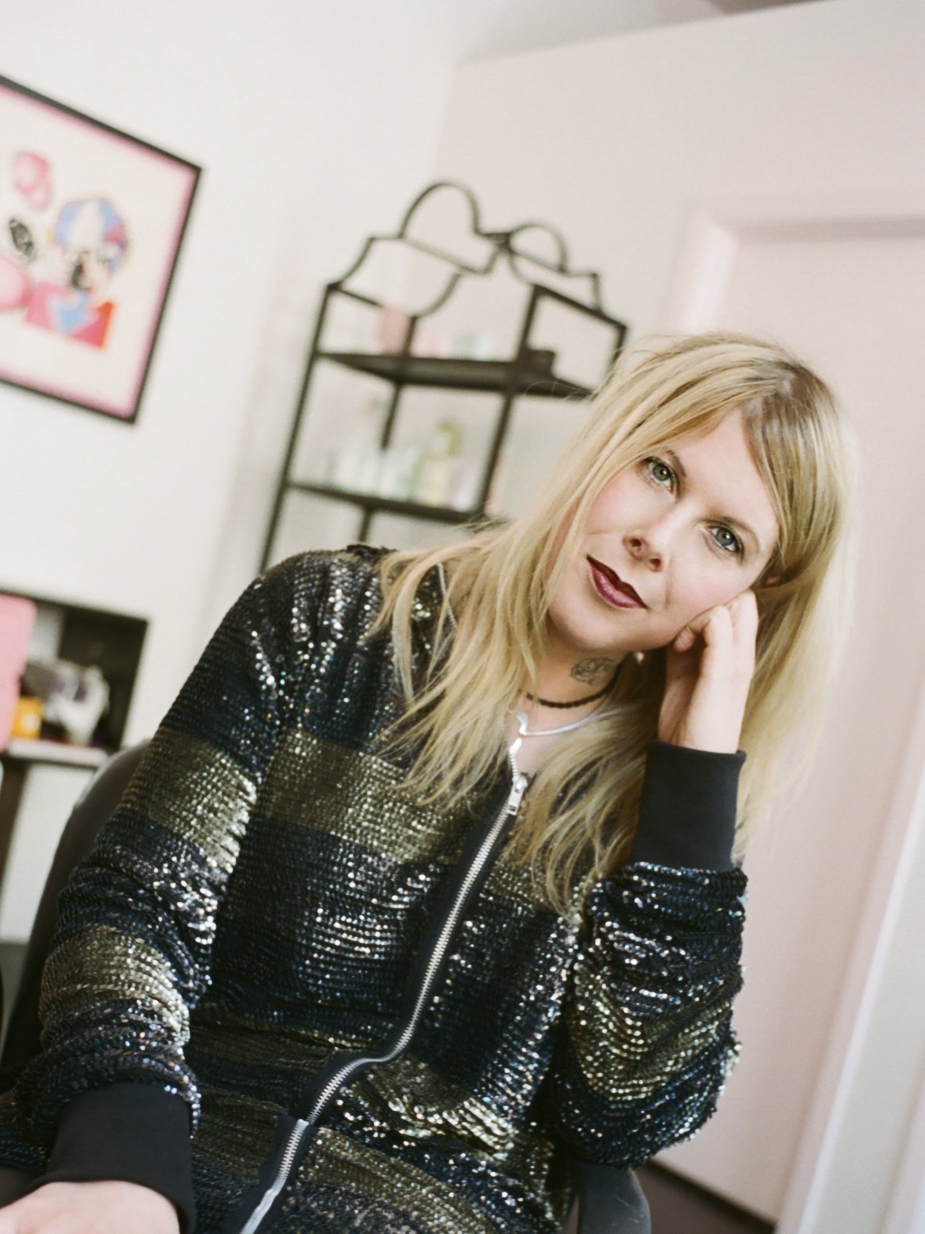Johanna Fateman, former member of Le Tigre and co-owner of Seagull Salon — the go-to salon for many of New York’s artists, writers, and musicians — possesses the steady, thoughtful disposition of someone who’s figured out some things about life. Salon owner is just one hat she wears; art critic, writer, musician, feminist, and mom are some others. She seems to have mastered the perfect career alchemy for creative and financial independence.
On a Monday afternoon, on the second floor of a building in Greenwich Village, a stylist hangs out in a chair chatting with a colleague. Nails are being done (by Gina Oh, nail art architect and manicurist for Nicki Minaj, Serena Williams, and Justine Skye among others), phones are being answered, blow dryers are whirring. Shaun Cottle aka Shaun SureThing, co-owner and lead stylist of Seagull as well as a longtime friend of Fateman’s, is mid-conversation with a client. Jeanise Aviles, a veteran color specialist and wearer of dynamic green eyebrows, is effusive in her love for Seagull. She tells me she never wants to leave — she’s found her home here.
Founded in 1971 in a small storefront on Christopher Street, Seagull was the first unisex barber shop in New York City (and possibly the whole country). Within a short walk of the Stonewall Inn, the salon has long been a home to artists, fashion editors, writers, musicians, and more. Fateman, with her background in almost all of these fields, is the perfect fit for a salon with walls covered in works by artists like Kathe Burkhart, K8 Hardy, and Sam McKinniss. i-D sat down with Fateman to hear about how the salon has evolved over the years, the symbiotic relationship between music and hair, and how sometimes the most punk rock thing you can do is learn how to administer a health insurance plan.
What inspired you and Shaun to take over Seagull in 2006? What did the salon look like at that time?
It was sort of in limbo. The previous owner [Liz Henao] was a friend of mine and a friend of my business partner Shaun. She was like, “You guys buy the salon. I want to move out of New York City.” Le Tigre had recently split up, so I had a small chunk of money but not enough to buy an apartment with.
I worked out a payment plan with Liz and bought Seagull. The old salon was tiny, like 400 square feet on West 10th Street, and it had been in that storefront for decades. We got a pretty good below-market lease. It was a constant fixer-upper, but it was cute. We were there for 10 years, and then the lease ran out. We had this battle with the landlord trying to negotiate something, and he wanted an astronomical monthly rent for it. In a way, it was a blessing because, finally moving off the ground floor, we got more space and were able to expand. There have been some growing pains; to fill the space you have to hire more people. It’s definitely been an intense year and a half.
How has your clientele grown and changed?
Because we’ve had such wonderful luck hiring creative people, it’s like the business is so shaped by the individual stylists and who they bring in. Before, I feel like we had a really good mix of West Village people who came in just because they walked by and people who commuted from different parts of New York. Now we have Jeanise [Aviles], who’s got a cult following for creative color and is sort of a trailblazer with more editorial and high fashion club color, and Steve [Karas] as well. The clientele has kind of morphed now that we have Gina [Oh], and we have people coming in for really insane nails. That brings a whole different energy, and those people are interested in getting their hair done too.
We’re also very lucky that people work here and stay for a long time unless they leave New York, so they all form the character of the salon. The overarching theme is kind of unconventional in terms of our accepting vibe. There are people who come here with all different kinds of aesthetic goals. It’s not about traditional beauty necessarily.
We have such a diverse clientele, especially in terms of gender-queer and trans people, and people with non-binary identities who are looking for something different. Maybe they’re tired of going to salons or other estheticians where they’re sort of challenged on their presentation, whether it’s facial hair or gender-appropriate style.

What sets Seagull apart? It seems like you all have such a strong community.
Some of that has to do with my background in the art world. There’s this whole history now of artists doing trades, getting their hair done and giving us prints or photographs [in return]. There’s definitely a strong creative community around Seagull. Also, I think the more high-end salons tend to be compartmentalized. There are colorists and stylists, and there’s more of an encompassing branding the stylists conform to. That’s just not what we do. We’re happy to have a range of personalities who have their own brand within our space and sort of their own specialities. I think it’s the kind of people we are and the kind of people who are attracted to Seagull. It’s reinforced the original vision.
What was your relationship with hair before owning the salon? Was hair something you were into?
I mean, not really. I was a musician before, and then I just had this strong feeling that I didn’t want to be reliant on my art as my income. When the band was over, it was like, “I want financial security, I want a job.” I bought myself a job, really, in buying the business. It’s been a real opportunity to be creative in different ways, and to keep learning and doing different things and keep sort of reinventing my career.
Sometimes the business is really demanding and I’m working full time on Seagull, but I’m basically working full-time as an art critic, too. I write for The New Yorker and Art Forum pretty consistently. I have this freelance career that, if I didn’t have another job or source of income, would be really hard to live on. Having some control over my financial life through owning a business has let me get back into creative work that doesn’t pay well.
Has your writing and career as a musician throughout the years fed into your work at the salon?
There’s a synergy between it all because the worlds really overlap here. We have music people and art people and people in publishing — editors and writers — coming to the salon. This is where things collide for me socially. It keeps things from being completely compartmentalized. When I have a big deadline and I’m at home writing, sometimes it’s very isolating. Being able to come here and do some work for the salon, it’s really nice; it combats that isolation.
What do you think the relationship is between hair and music?
In the sense of performance and expression, hair is obviously a huge element of everyone’s personal style. Any kind of time you spend in the public eye amplifies the meaning of everything that you do, so I think that there’s a relationship there to the extent that performers have to have a more refined relationship with their appearance. Not that they have to, but they’re sort of forced to confront the scrutiny or the platform that they have.
I really see salon work, especially for the stylists and colorists, as a creative profession. It’s also a service job, but it is very performative. I see how people create a persona in the way they present themselves as a stylist.
What have been a few unexpected things about running Seagull that you didn’t anticipate going in?
I mean, everything! I was luckily pretty naive about what it takes to run a business and employ people at this scale. I think I might have been scared off if I knew what it takes to set up a health insurance plan or a retirement account, or all the kind of financial administrative stuff that I think scares creative people away from starting businesses. At the same time, [I’ve had] a kind of DIY ethos about running a business where it’s like, look, other people have figured this out, I can figure this out.
When we opened Seagull, I bought Small Businesses for Dummies, you know what I mean? You can do it if you demystify it for yourself. So many artists are like, business, accounting, I can’t do it. If you have that attitude, you’re taking your own power away. You’re letting other people be the business owners, and you’re letting other people screw you because you don’t know what’s going on. [It’s about] taking some power back as an artist and as a woman, and saying, this is all stuff that I can learn. I do think there are certainly so many sexist obstacles to getting a lease for a business, getting a business loan, you’re going to confront people who push those buttons.
What are some connecting themes between the work that you’ve done with Seagull and as a writer and musician?
Independence, really, having some control over my life. This sounds corny but having a voice. This is a hair salon — I’m not idealizing it as my own art — but so many decisions are my decisions and are part of a creative process and part of collaborating with Shaun or our employees. In that sense, it’s really exciting, and it’s the same feeling I have about writing or music. That kind of sharing something with people and building something. The sense of adventure is the same.
What’s the secret to what you and Shaun have built with Seagull?
It comes down to the people who work for you and are doing the hair, and [setting] up a situation where people can succeed and feel comfortable enough to do their best work. It’s a process; everyone you hire, you have to get to know and understand how to help promote them and find the right clients for them. At the end of the day, it’s really the people.
People spend so much time on their brand identity or their graphic identity and their decor, but this is a service business. It’s about personal relationships so you have to take care of that. You have to fundamentally have love for that kind of culture and that kind of social environment or else it’ll just be empty.
Credits
Text Kelsey Lawrence
Photography Stanislaw Boniecki
